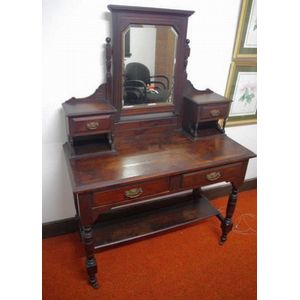Mahogany Dressing Table with Carved Arch Top & Spindles
You must be a subscriber, and be logged in to view price and dealer details.
Subscribe Now to view actual auction price for this item
When you subscribe, you have the option of setting the currency in which to display prices to $Au, $US, $NZ or Stg.
- Turned Legs - are legs which have been turned on a lathe. In use from the 16th century, turned legs on tables, chairs and cabinets became more frequent until, by the 1830s, the Georgian square or tapered leg was rarely found except in country pieces.
- Pierced Decoration - Ornamental woodwork with part of the background cut through and removed to produce an open-work pattern.
- Edwardian - The Edwardian period of English furniture and decorative arts design is named for Edward VII (1841 ? 1910) who was King of the United Kingdom and the British Dominions and Emperor of India for the brief period from 1901 until his death in 1910. It follows the Victorian period, in turn was followed by the Art Nouveau and Art Deco styles. In Australia, designs of this period are also known as being in the Federation style.
- Mahogany - Mahogany is a dense, close grained red-coloured timber from the West Indies and Central America. It was first imported into Europe in the the early 18th century and its use continued through the 19th century. It was popular for furniture making because of its strength, the wide boards available, the distinctive grain on some boards, termed flame mahogany and the rich warm colour of the timber when it was polished.. The "flame" was produced where a limb grew out from the trunk of the tree, and this timber was usually sliced into veneers for feature panels on doors, backs and cornices.
Some terms used to describe mahogany relate to the country from which it originally came, such as "Cuban" mahogany, "Honduras" mahogany etc. However unless the wood has been tested the names assigned are more a selling feature, rather than a true indication of the timber's origin. - Spindles - Short turned pieces, used as stretchers or back supports mainly in cottage chairs, couches and day beds. Turned shelf supports and the railings used in the backs and arms of day beds during the late 19th century are also referred to as spindles. Until the coming of the industrial age, spindles, like all turned pieces, were made by hand, and should show some slight variation. With the introduction of the factory lathe, spindles and turned legs became quite uniform and standard.
- Turning - Any part of a piece of furniture that has been turned and shaped with chisels on a lathe. Turned sections include legs, columns, feet, finials, pedestals, stretchers, spindles etc. There have been many varieties and fashions over the centuries: baluster, melon, barley-sugar, bobbin, cotton-reel, rope-twist, and so on. Split turning implies a turned section that has been cut in half lengthwise and applied to a cabinet front as a false decorative support.
- Stretcher - A horizontal rail which connects the legs of stools, chairs, tables and stands, to provide stabilisation of the legs. A stretcher table is any table with a stretcher base. The term is usually applied to substantial farmhouse tables, although many cabinetmaker's pieces, such as sofa tables, also have turned stretchers.
- Hardware - A general term applied to the metal fittings on an item of furniture, such as locks, hinges and handles. Whilst most furniture will usually have brass hardware as it does not rust, some earlier rustic objects such as coffers sometimes have iron hardware.
This item has been included into following indexes:
Visually similar items

Edwardian pine dressing table, 107 cm wide

A fine Napoleon III marble-topped Thuya and rosewood bedside cabinet, third quarter 19th century, the square top inset with veined white marble above a frieze drawer, an open compartment, and a low cupboard, with turned supports and feet, well-carved and m

A German Exhibition walnut stretcher based dressing table, circa 1880, with maker's mark of C. Prachtel, Berlin, Purveyor to the Empress, with a galleried upper section, a central mirror and three panelled and embellished drawers, the table with three draw

A Victorian mahogany dressing table, last quarter 19th century, the shaped top mounted with a gallery of small drawers and enclosed compartment and a crested mirror swinging between carved supports, with a central frieze drawer, on turned and gadrooned fro
